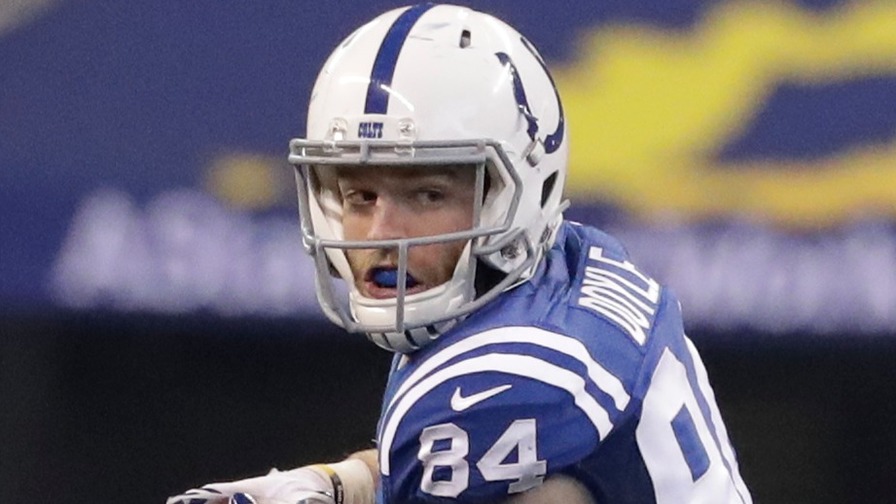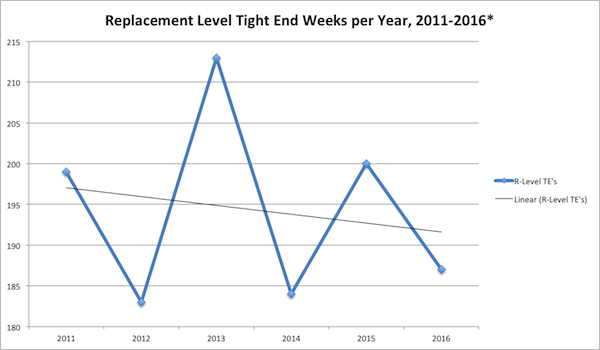The Tight End Position Is a Fantasy Football Dumpster Fire Right Now

Nothing in life ever stays the same.
Every second of every day, we are changing; imperceptibly, in infinitesimally small ways, we are changing. The famous philosopher John Locke was one of the first to theorize, in fact, that the you that you are -- reading this sentence right now -- is not the same you that clicked on the link to this article 30 seconds ago. Just as you are not the same paste-eating, nose-picking second-grader you were however many years ago, each mark of time that passes changes you.
So it goes with the National Football League as well, where the game inevitably progresses and evolves each year.
This also means that we must change our perceptions and values as they relate to fantasy football. One big evolution that we have to react to in 2016 is the fantasy viability of the tight end position. Whether it’s Jack Doyle, Cameron Brate, Xavier Grimble, or anyone else, it seems like fantasy-useful weeks are being put up by tight ends across the league, and they’re not just the stars we know and love.
Is this perception true? Is the tight end a better fantasy asset in 2016 than it has been in recent years?
Furnishing the Mind
This question has been boiling in my mind since the beginning of the season, when Indianapolis Colts second-string tight end Jack Doyle lit up the Detroit Lions for two touchdowns, and then followed that performance up with another 10 catches and 102 receiving yards in the following two games. We know the Colts historically love to use two tight ends in their base offense when they can, but the 2016 season was supposed to herald a shift to a three-wide set for them, featuring T.Y. Hilton, Donte Moncrief, and Phillip Dorsett, with Dwayne Allen the lone tight end in the base.
Instead, Moncrief got injured and the Colts have run their old “12 personnel†formations out again (“12†refers to one running back and two tight ends). This, in turn, has given Doyle a chance to see extra usage -- especially in the red zone.
Other similarly-buried tight ends have come out of the woodwork in 2016, such as C.J. Uzomah of the Cincinnati Bengals, who earned a shot with both Tyler Eifert and Tyler Kroft injured. Jesse James took over the red-zone component of the retired Heath Miller's job with the Pittsburgh Steelers. Blake Bell has earned some work as the San Francisco 49ers just try to find out what their future is going to look like at all.
But is the position as a whole presenting more usable fantasy value to us this year?
We know that the NFL has become a more pass-heavy league over the last two decades, and that, of course, will benefit its pass-catchers. The chart below shows the progression of the weekly average passing attempts for NFL teams from 2000 to 2016.

Most of us already know this, but it’s helpful to see just how extreme the progress of the passing game is in the NFL. But how much has the tight end benefited from this trend?
We Are Like Chameleons
Per-game averages are all fine and well in some contexts, but those numbers aren’t 100 percent reliable after only a five-game sample size. We need to look at weekly fantasy scores for players, and see just how well 2016’s crop of tight end talent measures up against that of history.
I took the average TE12 weekly finish (the last startable tight end in any given week, or “replacement levelâ€) from each week from 2011 onward and averaged them to see what bar a fantasy tight end had to clear in order for them to be startable. (And, therefore, fantasy viable.) The average fantasy score of the 12th-best tight end in a week (standard scoring) has been 7.18 fantasy points over the past five-plus years.
I then decided to check how many tight end weeks over the last six years have resulted in a weekly fantasy score of 7.18 points -- our threshold for startability. By punching that total into the search engine at Pro Football Reference, I found the following trajectory for fantasy tight ends since 2011 (2016 numbers prorated for 17 weeks).

In reality, replacement-level tight end performances have significantly dropped this season on a per-week basis, by almost one per week from last year. Each year has fluctuated wildly over the last five, but the overall trend shows that slightly fewer of these usable fantasy weeks are being produced on average. Why is that?
I looked at the annual per-game trends of a number of production categories for tight ends as well, and all of them have moved upward since 2000, right alongside the NFL’s passing proliferation. The table below outlines the increases from 2000 to 2016.
| Increases | RecYD/Game | Targ/Game | RecYD/Targ | RecTD/Game |
|---|---|---|---|---|
| 2000 to 2016 | +63.10% | +39.66%+ | 16.82% | +27.27% |
All of this shows a general increase in value, but it’s not translating to fantasy production. Why? In a vacuum, tight end value is up. More passing means more overall production. The problem is that no player produces in a vacuum.
When we look at how much of each team’s production the tight end is earning on average -- what we call the “market share†-- it has diminished this season, even from last year’s marks. Whether we’re talking about target market share, reception market share, market share of receiving yards, or market share of receiving touchdowns, every one of those rates is at or below pre-2003 levels. The NFL as a whole peaked in its tight end usage from 2005 to 2012.
Overall, the trendlines show an increase, but the last three years and 2016 itself actually mark part of a massive decline in the tight end’s usage as a core receiving threat in offenses.
Knowledge Beyond Experience
So, why is it that people seem to be intrigued by tight end usage this season for fantasy purposes, when they clearly aren’t producing like we have imagined?
First of all, the overall production of tight ends has swung upward (as we explained before), and therefore the perception is that they’re more valuable.
In addition, it’s possible that the spate of injuries, suspensions, and roster moves for tight ends at the beginning of this season has provided us with fresh looks at a number of new tight ends, without actually changing the value of the position as a whole. Connor Hamlett, Garrett Celek, Trey Burton, Austin Hooper, and Hunter Henry have all been startable tight end options this season, but they were all fill-ins for injuries in the week they produced; they haven't become viable fantasy assets in addition to the starters they supplanted for their big fantasy performances.
Finally, another big trend I noticed is in how many tight ends have seen targets on a per-game basis this season compared to the last 16 years. We are down to 2.34 tight ends used per game this year, a 16 percent drop from last year’s 2.77. Perhaps the fact that work is being consolidated more closely in a fewer number of tight end options is yet another trick of the eye convincing us.
Some things never change, and tight ends’ value in fantasy is one of them.
















